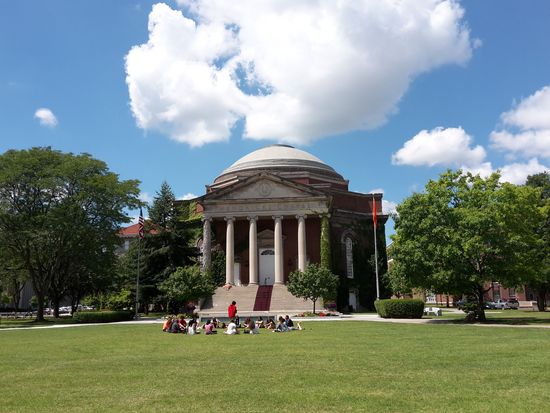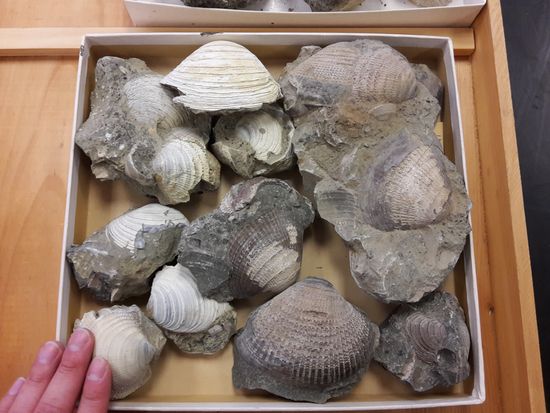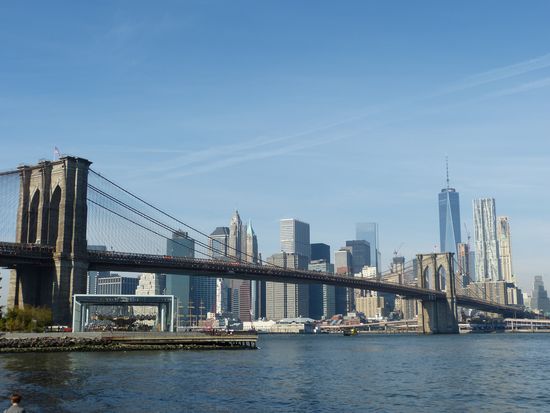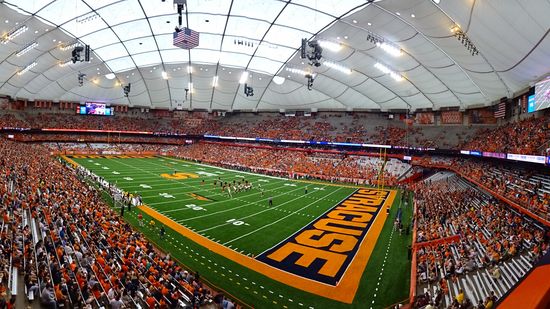Intra-annual growth increments in fossil bivalve shells from Antarctica - high-resolution insights into a greenhouse world?
Annual shell growth in bivalves is understood relatively well. However, the shells of the Eocene bivalve species Cucullaea raea from Seymour Island (Antarctic Peninsula) might provide the potential to extend the temporal resolution of shell growth to an intra-annual (daily?) scale. The main focus of this project was to visualize and identify those intra-annual growth increments within thin sections in combination with transmitted light, luminescence, reflected light and polarized light microscopy. A big part of this project, including the work in the laboratory, was done at Syracuse University (SU) in collaboration with Linda Ivany (Professor for Palentology at SU), David Moss and Emily Judd (both PhD students at SU). Since the analysis of such fine structures requires special microscope equipment, we were lucky to establish an additional collaboration with Robert Silver (Professor for Biology at SU) at the Forensic and National Security Sciences Institute (SU).
In addition to this more than exciting scientific project, I had the opportunity to participate in a palaeontological field trip in the Albany area of eastern New York, which was led by Chris McRoberts (State University of New York College at Cortland) and Linda Ivany (SU). During those three days I was also given the chance to give the participants an understanding of my research related to fossil bivalves (sclerochronology) by giving an evening talk entitled "Sclerochronology? Unraveling environmental histories from skeletal diaries".
I also participated in a number of different recreational activities in my spare time in order to immerse myself in American culture, which complemented this great exchange experience: participating in a challenger course; watching American football at SU; joining the SU Earth Sciences broomball team; attending an outstanding BBQ (starring 2 pigs and 36 chicken); visiting the New York State Fair; experiencing the Niagara falls and so much more.
One of the absolute highlights was my time with Hugh Ducklow (and his wife Beverly) at New York City and the Lamont-Doherty Earth Observatory (Columbia University, New York, USA). Not just did I have the chance to present my recent research when giving a talk at Lamont ("Past seasonal and inter-annual variability derived from Holocene bivalve shells" on October 19th, 2015), I also had the chance to discuss a broad variety of science related topics with a number of scientists at Lamont. This was an incredibly enriching and memorable experience for an early career scientist like me.
In my final week in the United States, SU and Thomas Brey (AWI) made it possible for me to participate in the Geological Society of America Annual Meeting in Baltimore (November 1st to 4th, 2015). This conference participation gave me the chance to discuss and network with a huge number of scientists from a wide variety of disciplines in the Earth sciences and to present my research in the form of a poster.
As for my visit to Argentina, it is very important to me to thank a number of people that made this exchange possible and such an enriching experience. First of all, a very special thank you (again) to Doris Abele, Nancy Lange, Gerhard Kuhn and Thomas Brey (all AWI/IMCONet), who were of the greatest support/help especially in advance of the trip and who helped me navigate the complicated task of receiving a visa for the US. I would like to thank Linda Ivany, Robert Silver and everybody at the Earth Sciences Department at SU for their support, for sharing fun recreation activities with me and for welcoming me with open arms from the very first day on. Beverly and Hugh Ducklow, thank you for a most amazing time in New York City and at Lamont. Last but not least, a huge thank you to David and Melanie Moss and their "children" (dogs) Jack and Darwin. Thank you for so much for having me as a guest at your house, providing me with a home and an outstanding full board care.
Lars Beierlein






